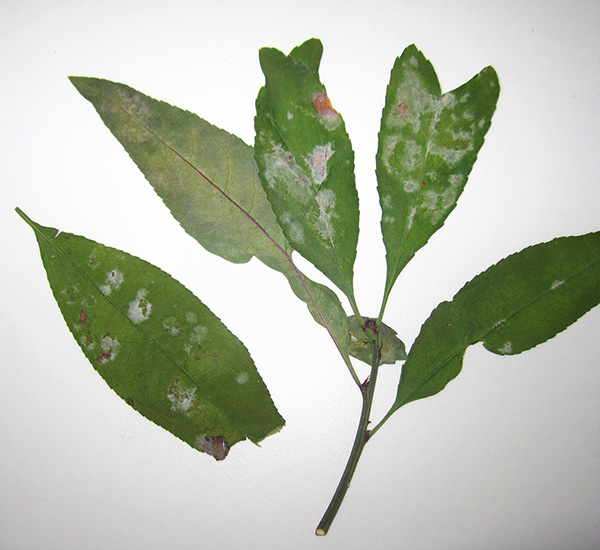Powdery mildew of Prunus caused by Podosphaera cunningtonii
Powdery mildew caused by the fungus Podosphaera cunningtonii affects peach, Mahaleb cherry and ‘Garnem’, which is an almond-peach rootstock. This fungus can lower productivity and possibly infect other kinds of Prunus.
Symptoms and detections
The most obvious symptoms on the ‘Garnem’ rootstock are flat, whitish, and chalky patches of growth on the upper and lower surfaces of the leaves.

Symptoms on grafted plants may appear differently. Though powdery mildews rarely kill plants, they can reduce yields from up to 20 to 40%.
In March 2021 Podosphaera cunningtonii was found in Victoria on ‘Garnem’ rootstock from a commercial premise, and steps were taken to prevent its spread. Testing of historical herbarium specimens from 1977, identified three records of the powdery mildew from Victoria, and another three from New South Wales. Only one of those detections was outside a quarantine glasshouse. It was on a peach sample collected in 1996 from a home orchard in New South Wales. Also, the fungus was not detected in the 2018 to 2020 surveillance of almond plantings.
Management
At the time of writing there are no registered or permitted chemical sprays for powdery mildew caused by Podosphaera cunningtonii. For information about the off-label use of fungicides, please visit the Off-label chemical use webpage.
Existing fungicide spraying programs may be largely controlling disease. There are no documented losses, despite the fungus having had opportunity to spread by its airborne spores for at least 25 years.
Powdery mildew fungi usually produce two types of spores, asexual and sexual, which have different functions.
- Asexual spores are produced on the white surface growth, on mass, probably survive for only a few days and are dispersed largely by wind over long distances. Their function is to spread the disease rapidly around the crop and between crops.
- The sexually produced spores are formed within plant tissues such as the leaves. These spores carry the fungus over from one season to the next.
Powdery mildews can cause severe disease even in warm and dry climates, provided there are periods of high relative humidity. Thus, spraying would be especially important when conditions remain humid.
The disease can be better managed in:
Orchards by:
- Spacing plants and managing canopies to create good air movement and reduce humidity
- Removing and destroying pruned material and leaf litter from the orchard, as these can harbour fungal spores that can carry over from one season to the next
- Washing down farm machinery and equipment, especially between farms, as these could carry spores or infected plant material.
Glass and shade houses:
- By avoiding high humidity:
- Don’t use overhead irrigation
- Spray when weather conditions enable drying at night
- Open vents when temperatures rise to replace warm moist air with drier, cool air
- Heat the growing area at night, which will reduce condensation
- Create air movement with fans.
- By hygiene practices:
- Remove leaf litter, dead plants, and crop debris
- Keep floors clean
- Disinfect benchtops, tools, floors, and equipment like trolleys
- Change or disinfect gloves regularly.
On farm Biosecurity
Source planting material from a reliable supplier as powdery mildew can be moved over long distances on infected plants and plant material such as cuttings and tissue cultures.
In the event of an outbreak of disease:
- quarantine and if necessary
- consider destroying infected material
- employ hygiene practices as described previously.
Reporting an unusual plant insect pest or disease
Report any unusual plant pest or disease immediately using our online reporting form or by calling the Exotic Plant Pest Hotline on 1800 084 881. Early reporting increases the chance of effective control and eradication.
Please take multiple good quality photos of the pests or damage to include in your report where possible, as this is essential for rapid pest and disease diagnosis and response.
Your report will be responded to by an experienced staff member, who may seek more information about the detection and explain next steps.
Report onlineReferences
Agriculture Victoria (2021) PIDS Podosphaera cunningtonii – 2021-56, CCEPP Secretariat.
Agrios, G (2005) Plant Pathology. 5th Edition, Elsevier Academic Press, Amsterdam, pp 448–52.
Smith RL, May TW, Kaur J, Sawbridge TI, Mann RC, Pascoe IG, Edwards J (2021) Re-evaluation of the Podosphaera tridactyla species complex in Australia. Journal of Fungi 7: 171.